

The one best-practice to rule them all – Part 4. Hi there Welcome to the fourth post in my series on how to deal with the true root cause of project failure. The first three posts were really to set the scene for this post where I will explain the basics of my craft for resolving some of this. First up, I described my journey through the maze of of well known methodologies and best-practice standards, trying to make sense of a character known as “SharePoint vs Skype guy”. After seemingly taking one step back for every two steps forward, I finally found an area of research that I strongly identified with – the concepts and phenomena of wicked problems. I described how I have come to believe very strongly in the principle that understanding a problem comes from exploration of potential solutions, and that the act of exploring solutions will change your understanding of the problem. This sense-making process is utterly critical to project success.
Self-Paced Issue Mapping Course. Self-Paced Issue Mapping Course CogNexus is pleased to offer our Self-Paced Issue Mapping Course, which is based on our previously offered Issue Mapping Webinar Series.

The Self-Paced Course enables participants to listen to recordings of our previous live classes and then to interact with a live instructor for homework assignments and questions. The benefit of the Self-Paced Course is that it provides exactly the same information as the live course plus feedback from a real instructor, but also allows you to complete the Course according to your own schedule. Find out more by reading our FAQ. Sensemaking. In information science the term is most often written as "sense-making.
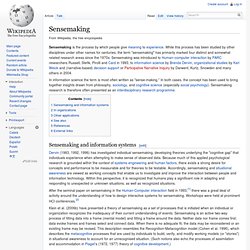
" In both cases, the concept has been used to bring together insights drawn from philosophy, sociology, and cognitive science (especially social psychology). Sensemaking research is therefore often presented as an interdisciplinary research programme. Sensemaking and information systems[edit] Dervin (1983, 1992, 1996) has investigated individual sensemaking, developing theories underlying the "cognitive gap" that individuals experience when attempting to make sense of observed data.
Because much of this applied psychological research is grounded within the context of systems engineering and human factors, there exists a strong desire for concepts and performance to be measurable and for theories to be testable. After the seminal paper on sensemaking in the Human-Computer interaction field in 1993,[1] there was a great deal of activity around the understanding of how to design interactive systems for sensemaking. The what and whence of issue-based information systems. Over the last few months I’ve written a number of posts on IBIS (short for Issue Based Information System), an argument visualisation technique invented in the early 1970s by Horst Rittel and Werner Kunz.
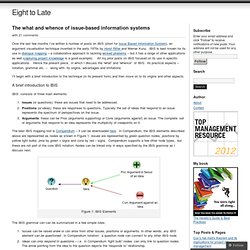
IBIS is best known for its use in dialogue mapping – a collaborative approach to tackling wicked problems – but it has a range of other applications as well (capturing project knowledge is a good example). All my prior posts on IBIS focused on its use in specific applications. Hence the present piece, in which I discuss the “what” and “whence” of IBIS: its practical aspects – notation, grammar etc. – along with its origins, advantages and limitations. Wicked problem. A wicked problem is a problem that is difficult or impossible to solve because of incomplete, contradictory, and changing requirements that are often difficult to recognize.
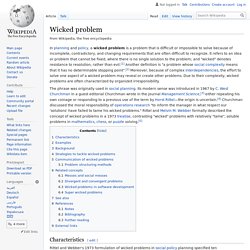
It refers to an idea or problem that can not be fixed, where there is no single solution to the problem. The use of the term "wicked" here has come to denote resistance to resolution, rather than evil.[1] Another definition is "a problem whose social complexity means that it has no determinable stopping point".[2] Moreover, because of complex interdependencies, the effort to solve one aspect of a wicked problem may reveal or create other problems. Characteristics[edit] Rittel and Webber's 1973 formulation of wicked problems in social policy planning specified ten characteristics:[4] Conklin later generalized the concept of problem wickedness to areas other than planning and policy; Conklin's defining characteristics are:[6] Examples[edit] Background[edit]
Issue-Based Information System. To quote from their original paper, "Issue-Based Information Systems (IBIS) are meant to support coordination and planning of political decision processes.
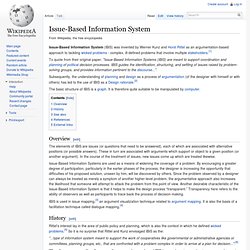
IBIS guides the identification, structuring, and settling of issues raised by problem-solving groups, and provides information pertinent to the discourse... ". Subsequently, the understanding of planning and design as a process of argumentation (of the designer with himself or with others) has led to the use of IBIS as a Design rationale.[2] Overview[edit] The elements of IBIS are issues (or questions that need to be answered), each of which are associated with alternative positions (or possible answers). These in turn are associated with arguments which support or object to a given position (or another argument). The what and whence of issue-based information systems.
Over the last few months I’ve written a number of posts on IBIS (short for Issue Based Information System), an argument visualisation technique invented in the early 1970s by Horst Rittel and Werner Kunz.

IBIS is best known for its use in dialogue mapping – a collaborative approach to tackling wicked problems – but it has a range of other applications as well (capturing project knowledge is a good example). All my prior posts on IBIS focused on its use in specific applications. Hence the present piece, in which I discuss the “what” and “whence” of IBIS: its practical aspects – notation, grammar etc. – along with its origins, advantages and limitations. Horst Rittel. Citation Query PHIBIS: Procedurally Hierarchical Issue-Based Information Systems. Design Environments for Constructive and Argumentative Design by Gerhard Fischer, Anders Morch, Raymond Mccall - In Human Factors in Computing Systems, CHI'89 Conference Proceedings (Austin, TX); ACM , 1989 "...
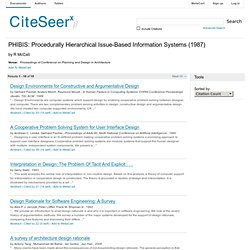
Design Environments are computer systems which support design by enabling cooperative problem solving between designer and computer. There are two complementary problem solving activities in design: constructive design and argumentative design. We have created two computer-supported environments, CR ... " Tackling Wicked Problems Collaboratively: The Multicentric IBIS. Tackling Wicked Problems Collaboratively: The Multicentric IBIS This is a December 2011 concept paper on Multicentric Issue-Based Information System (MctIBIS).
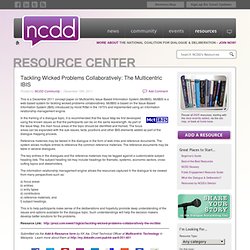
MctIBIS is a web based system for tackling wicked problems collaboratively. MctIBIS is based on the Issue-Based Information System (IBIS) introduced by Horst Rittel in the 1970′s and implemented using an information relationship management engine. In the framing of a dialogue topic, it is recommended that the Issue Map be first developed using the known issues so that the participants can be on the same wavelength. As part of the Issue Map, the main focus areas of the topic should be identified and framed. Reference materials may be tabled in the dialogue in the form of web links and reference documents. Report on a development project use of an issue-based information system.